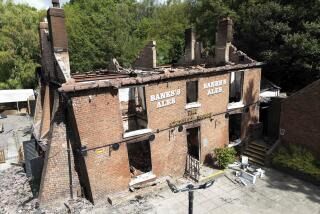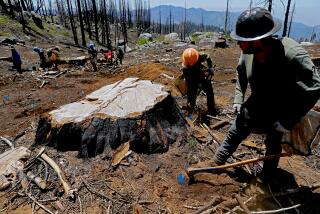Windsor Castle Coming Back From the Flames
WINDSOR, England — Specialists probing England’s most graceful and beloved hulk, a 900-year-old royal refuge and modern tourist mecca savaged by fire, emerged from it wreathed in smiles Thursday: Windsor Castle lives again.
After more than three years, a complex and costly restoration project of heroic scale is entering its final phase, on time and on budget for completion in 1998, curators said.
“We have the structure complete; now we can begin on the decoration,” said coordinating architect Alan Frost at a public progress report announcing the closing chapter of the $60-million restoration of a sovereign’s pride.
As work continues, nine major state halls and more than 100 rooms damaged in the 1992 fire are yielding fascinating insights about the life, times and eating habits of castle denizens across 10 centuries.
The burned-out area is being reborn even as daily lines of tourists--1.2 million a year--coil patiently around imposing gray stone walls for a glimpse inside the undamaged larger area of the storybook castle.
“We feel a little paternalistic about this place, so it was like cutting off your right arm to see that fire. Now we can believe that it’s growing back,” said Harry Parker, as he and other council members from nearby Old Windsor clambered over scaffolding Thursday. Their village was a thriving Saxon settlement when William the Conqueror and his invading Normans erected their castle here on a wooded hillside west of London in about 1070. Royalty has lived here without interruption ever since, in the world’s largest occupied castle.
About 70% of the cost of the restoration comes from admissions to Windsor and Buckingham Palace. The rest comes from British taxpayers.
Electrical repairs were underway in the royal apartments where Queen Elizabeth II and her family spend most weekends when the fire broke out before noon on Nov. 20, 1992.
With flames bursting above mock Gothic battlements and historic towers blazing like Roman candles, it was not until the next day that 250 firefighters controlled the blaze. About 75,000 square feet were destroyed or damaged, representing about a third of the royal living areas and 10% of the whole castle, by Frost’s reckoning.
Restoration and reconstruction have bared centuries of secrets hidden by a procession of builders anxious to please demanding monarchs. At least 10 construction periods have been documented, including major work in the 12th, 13th, 14th, 17th and 19th centuries.
“Without understating how disastrous the fire has been, there have been some silver linings. We have been able to learn much more about the history, the construction and the architecture of the castle, and we’ve been able to polish the skills of craftsmen,” said architect Peter Riddington.
The special challenge to modern planners, said projects manager Philip Rowley, is that over the centuries Windsor Castle acquired different types of construction and contrasting artistic styles in adjoining rooms.
In the 200-foot-long St. George’s Hall, carpenters Roger Farr and Paul Maisey were fitting massive rafters and trusses of green oak for a vaulted medieval ceiling. In a state reception room next door, Fiona Jones was repairing delicate white plaster flowers on a ceiling that is rococo, an artistic fashion born centuries later.
Researchers working in the fire-ravaged medieval kitchen came upon a well more than 100 feet deep, abandoned and filled with debris when the area was roofed over. They also found a 13th century kitchen mitten and animal bones that somebody forgot to throw out centuries ago.
Of particular interest, said Steven P. Brindle of English Heritage, which oversees national monuments, were three cesspits uncovered in the fire’s ruins. They contained human waste from the 12th century.
“Laboratory analysis has shown that people ate 15 kinds of meat and fish and 30 kinds of fruit and vegetable,” said Brindle. “All are known and consumed by us today, though we’ve identified some species of lampreys and eels you won’t find on many modern dinner tables.”
Frost, the coordinating architect, said the reconstruction will leave Windsor better than the workers found it.
“It’ll be more of a castle and less of a hospital with patches covered over by lots of glossy paint. You’ll be able to see the Gothic architecture now.”
John Tiltman, a director of project services, noted that more than 1.5 million gallons of water were pumped on the fire and much of it seeped into ancient walls that are nearly 10 feet thick in places. “We’ve been drying them out ever since,” he said.
With about 95% of the moisture now gone, Windsor is already drier than it has ever been.
More to Read
Sign up for The Wild
We’ll help you find the best places to hike, bike and run, as well as the perfect silent spots for meditation and yoga.
You may occasionally receive promotional content from the Los Angeles Times.






